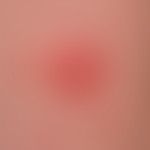Synonym(s)
HistoryThis section has been translated automatically.
The word "psora" was used as early as 129-99 p.C. by the Greek physician Galenos (Galen) to describe scaly and itchy skin diseases, although no distinction was made between atopic dermatitis, psoriasis, skin tuberculosis or leprosy. Specifically, the English dermatologist Robert Willan first described psoriasis in 1809. 30 years later it was the Viennese Ferdiand v. Hebra who separated psoriasis from leprosy. In 1879, the German dermatologist Heinrich Köbner described the isomorphic stimulus effect (Köbner phenomenon) named after him in relapsing psoriasis. Originally, this phenomenon was used to distinguish psoriasis from syphilitic infections.
First therapy approaches refer to sunlight in psoriasis. Already in pre-Christian times improvements of "leprosy" under UV influence were described. In the 2nd half of the 19th century, coal tar, chrysarobin, pyrogallol, bea-naphthol, and intramuscularly injected sulfur were used. In the 1st half of the 20th century, the therapeutic spectrum expanded to include radiotherapies, arsenic, artificial UV, intravenous salicylic acid, fever therapies, injections of adrenal extracts, and others.
DefinitionThis section has been translated automatically.
Common (about 100 million people worldwide are affected), acute or chronic, HLA-associated "inflammatory skin disease" provoked by exogenous and endogenous stimuli, with T-cell-mediated autoimmunesis, occurring at all stages of life and affecting about 2% of the Central European population. Psoriasis is based on a complex genetic predisposition. Familial accumulations are known. Clinically, characteristic localized or generalized papules or plaques are found, emphasized on the extensor side, usually symmetrically distributed, with varying degrees of consistency (palpation firm like leather), sharply demarcated, red or covered with white scales. Rarer are pustules or vesicles. Joint involvement of varying degrees (seronegative polyarthritis) is found in about 20-30% of psoriatic patients. Crohn's disease and uveitis are commonly associated with psoriasis. Due to pathophysiological and genetic similarities, psoriasis can be counted among the group of IMID(Immune-Mediated Inflammatory Diseases).
You might also be interested in
ClassificationThis section has been translated automatically.
Clinical variants of psoriasis with sometimes very different courses are:
- Psoriasis plaque type:
- Psoriasis stationary plaque type(psoriasis vulgaris chronic stationary plaque type)
- Psoriasis relapsing plaque type(psoriasisvulgaris chronic-active plaque type)
- Alternatively, 2 types of non-pustular psoriasis can be defined:
- Type I psoriasis (with early onset, <40 years of age, usually familial clustering and HLA-Cw*06.02 allele association)
- Type II psoriasis (with late onset, >40 years, no familial clustering, no association with HLA alleles)
- Psoriasis guttata (acute, exanthematic psoriasis)
-
Psoriasis inversa
- Psoriasis palmaris et plantaris
- Psoriasis intertriginosa
- Erythrodermia psoriatica (psoriatic erythroderma, as a maximum variant of psoriasis vulgaris).
-
Pustular psoriasis:
- Pustular psoriasis (generalized type):
- Pustular psoriasis (localized type):
- Psoriasis pustulosa palmaris et plantaris (Königsbeck-Barber type)
- Psoriasis pustulosa palmaris et plantaris(pustular bacterid Andrews type)
- Acrodermatitis continua suppurativa (acral type or Hallopeau type).
- Psoriasis arthropathica
- Special forms of psoriasis:
The individual clinical forms are defined on the one hand by their course (acute - chronic), on the other hand by the localization (psoriasis inversa, psoriasis palmo-plantaris) or by the occurrence of pustules (psoriasis pustulosa) or by other organ manifestations (psoriasis arthropathica).
The severity of psoriasis can be classified according to the percentage of body surface area affected, BSA: Body Surface Area, or according to the PASI score.
- mild psoriasis: BSA< 2% /(PASI < 5)
- moderate psoriasis: BSA 2-10% /PASI 5-20
- severe psoriasis: BSA> 10% /PASI >20
Current clinical classification of psoriasis (according to guideline)
- mild psoriasis: PASI <= 10/BSA <= 10/ DLQI <= 10
- moderate-severe psoriasis: PASI > 10/ BSA > 10/DLQI > 10
Occurrence/EpidemiologyThis section has been translated automatically.
Prevalence of psoriasis in different countries:
- Germany: 1-2% (-3%) of the population. If one parent is affected, the prevalence is around 14%.
- Denmark: 2.9% of the population.
- Sweden: 2.3% of the population.
- USA: 2.2% of the population (various American studies have also described prevalence rates of between 4.0-4.7%).
- China: 1.7% of the population.
- UK: 1.6% of the population.
- Sweden: 1.4% of the population (already mentioned above with other percentages)
- Norway: 1.4% of the population.
- Norwegian Laplanders: 0.6% of the population.
- Spain 1.4% of the population.
- India: 0.7% of the population.
- Africa: 0.4-0.7% of the population.
- East Africa: 0.7% of the population.
Prevalences of 0.1-1.0% are given for children. In a larger collective (n= 293,181 children), the prevalence was 0.45% (Jacobi et al. 2016).
EtiopathogenesisThis section has been translated automatically.
I. Endogenous factors
- Genetics: there is no doubt that genetic disposition plays a decisive role. This is confirmed by familial clustering and by studies on monozygotic twins. In a larger study of 15 monozygotic twins, 11x concordant behavior was detectable, 4x discordance. To date, >50 gene loci and gene variants associated with psoriasis have been identified in genome-wide association studies. Overlaps with other inflammatory diseases can be detected. Genetic markers significantly associated with psoriasis are referred to as "psoriasis susceptibility loci" - PSORS1- PSORS15 - of which PSORS1 is by far the most important genetic determinant.
- PSORS1 is the main predisposition factor for psoriasis in the early years of life with a severe course (type I psoriasis) and reflects the known association with the gene for the human leukocyte class I antigen(HLA-Cw 06:02).
- HLA associations: associations with HLA-B13, HLA-Bw57, HLA-Cw6, HLA-B27 (HLACw1, HLA-DR4 and HLA-DR7) have been demonstrated. HLA-Cw*06:02 is the main risk allele for psoriasis (early onset/severe course/carriers of this allele are affected 10 times more frequently by psoriasis). HLA-B27 is associated with psoriatic arthritis in addition to numerous other diseases.
- HLA-Cw6 allele: The worldwide frequency of the HLA-Cw6 allele varies greatly, with a generally higher frequency in Caucasians than in Asians (Huang YW et al. 2021). Phenotypically, HLA-Cw6 has been found to be associated with guttate psoriasis. Stress, obesity and streptococcal pharyngitis are frequently observed in HLA-Cw6-positive patients. The Köbner phenomenon can also occur more frequently in this population. HLA-Cw6-positive patients appear to respond better to methotrexate and ustekinumab. However, this difference in the efficacy of ustekinumab was only moderately detectable in a post-hoc analysis (Chen L et al. 2018).
- HLA-Cw1: The prevalence of HLA-Cw6 was expressed much lower than that of HLA-Cw1 in some Asian countries (Huang YW et al. 2021). HLA-Cw1 positivity has been associated with erythrodermic psoriasis, pustular psoriasis and the axial type of psoriatic arthritis. Furthermore, HLA-Cw1 positive psoriatic patients appear to be more likely to not respond to conventional therapies (Huang YW et al. 2021).
- HLA-B27: Another HLA class I antigen, HLA-B27 is mainly associated with psoriatic arthritis (+ ankylosing spondylitis + other rheumatic diseases).
- Other susceptibility loci known and defined to date with a significant association with psoriasis are:
- PSORS2/syn. CARD14/(gene locus: 17q24-q25)
- PSORS3 (gene locus: 4q)
- PSORS4 (gene locus: 1q21)
- PSORS5 (gene locus: 3q21)
- PSORS6 (gene locus: 19p)
- PSORS7 (gene locus: 1p)
- PSORS8 (gene locus: 16q)
- PSORS9 (chromosomal region 4q28-32; associated with early onset of disease in the Chinese population)
- PSORS10 (chromosome 18p11.23)
- PSORS11 (chromosome region 5q31.1-q33)
- PSORS12 (chromosome 20q13)
- PSORS13 (chromosome 6q21)
- PSORS14 (chromosome 2q14.1)
- PSORS15 (chromosome 2q36)
- Apparently, there is a genetic network with a variable, disease-typical "gene signature" that can be activated by various endogenous or external factors. In psoriasis (see also atopic eczema), this gene network is influenced by inflammatory (Th1 and Th17 cells) cytokines (e.g. interferon gamma/TNF-α/other interleukins). It has been proven that a single nucleotide polymorphism of the TNF-α gene is associated with a significant predisposition to psoriatic arthritis. This TNF-α gene polymorphism is also related to the severity of psoriasis and its response to TNF-alpha blockers (e.g. etanercept).
- Antimicrobial peptides (AMPs): There is sufficient evidence that overexpression of antimicrobial peptides, in particular cathelicidin, beta-defensin 2, psoriasin (=S100A7) and ribonuclease 7(RNAse 7), plays an important role in the pathogenesis of psoriasis (cf. also the low tendency to infections in psoriasis vulgaris!). It has been shown that the cathelicidin LL37 (see also cathelicidins) binds and complexes its own cytosolic DNA (these are detected in psoriatic keratinocytes!). The complexes can induce an interferon response with an inflammatory reaction (see inflammasome below).
- Functional disorders of the skin barrier: Several gene loci or gene variants affect genes with functions for the skin barrier (e.g. the genes: LCE3A, LCE3B, LCE3C, LCE3Bdel, see also Epidermal differentiation complex). It has been shown that the deletion of LCE3B and LCE3C (LCE3B/C-del) is a widespread psoriasis risk factor. LCE3A is directly adjacent to LCE3B/C and is functionally linked to it. Functional analyses show that LCE3 proteins, and LCE3A in particular, exhibit defensin-like antimicrobial activity against a variety of bacterial taxa, even at low micromolar concentrations.
- Immunological features: Other variations involve genes associated with activation of the immune system. These include CARD14, NFKBIA, REL, TYK2, IL28RA, TRAF31P2.
II Exogenous triggers
- 1. medications: There is well-founded evidence that various medications are capable of maintaining or triggering psoriasis vulgaris. These include:
- Beta-blockers (e.g. propanolol)
- Calcium channel blockers (e.g. diltiazem)
- Glucocorticoids (especially after discontinuation or reduction of therapy)
- lithium
- Antimalarials (e.g. chloroquine)
- NSAIDs (naprofen, diclofenac, indomethacin)
- Various antibiotics (e.g. macrolide antibiotics)
- gold
- TNF-alpha blockers for inflammatory bowel disease (see case 2 below)
- Interleukin-4/13 receptor blockers, e.g. dupilumab.
- 2. local trauma (the Köbner phenomenon can also be classified as mechanical trauma)
- 3. acute dermatitis solaris; dermatitic UV radiation can be triggering in relapsing psoriasis (the opposite is also reported)
- 4. irritative local therapies
- 5. infections (e.g. streptococcal angina)
- 6. emotional stress
PathophysiologyThis section has been translated automatically.
Keratinocytes/keratins: Keratinocyte stimulating mediators (TNF alfa, IL-8, granulocyte macrophage colony-stimulating factor = GM-CSF) result in a proliferation stimulus. The cell cycle of keratinocytes is accelerated more than 8-fold. Cells of the basal cell layer need only 4 days to reach the str. corneum. 25% of keratinocytes (increased 3-fold) are in the proliferative S-cell cycle phase. Such proliferation-promoting mediators are also produced by keratinocytes themselves (interleukins: IL1, IL6, IL8, IL17A, interferon gamma, TNF, transforming growth factor alpha (TGF-alpha) and GM-CSF (see growth factors below). Furthermore, interleukins-17 and -22 are responsible for keratinocyte hyperplasia. These are produced by the Th17 cells. The structural proteins of keratinocytes are also altered (reduction of suprabasal keratins 1 and 10; neoexpression of keratins 6 and 16). The role of the cytokine "thymic stromal lymphopoietin", which is produced in psoriatic keratinocytes, has not yet been definitively clarified. Evidence suggests that TNF-alpha and interleukin1-beta can induce CCL27 in basal keratinocytes.
Autoantigens: Various potential autoantigens, such as ADAMTS-like protein 5 expressed by melanocytes and the antimicrobial peptide LL37, are important for psoriatic inflammation. Both proteins are recognized by TH17 cells after binding to the protein HLA-C*06:02 (see HLA system) and thus initiate psoriatic inflammation. Remarkable is a structural homology of keratin 17 with M-proteins of streptococci. In this respect, keratin 17 also presents itself as a potential autoantigen. Furthermore, heat shock proteins (HSP) seem to play an important role in the pathogenesis of psoriatic inflammation. For example, HSP 90 has been linked to affected cell survival and cytokine signaling in psoriatic patients.
Lymphocyte/homing signaling: Probably at the beginning of the psoriatic inflammatory cascade are activated dendritic cells (DCs) and macrophages, which are stimulated to secrete pro-inflammatory cytokines such as IL-1, IL-6, IL-12, IL-17, IL-23 and TNF-alpha. This activates interferon gamma producing CD4+ T lymphocytes . This process leads to the maturation of naïve T cells into Th17- cells and other inflammatory Th cell populations such as Th-1 lymphocytes (Th1 lymphocytes; no IL-4 production). Th-1 lymphocytes (as well as Th17 cells) play a central role in the pathogenesis of psoriasis (blockade of CD4 T lymphocytes by anti-CD4-AK leads to a clinical improvement of psoriasis, other lymphocyte-suppressive drugs such as ciclosporin, fumaric acid esters, as well as PUVA therapy, among others, also cause this effect). The activated T-lymphocytes receive an "address" through the expression of certain surface markers, which defines the place where they are needed. These so-called "homing" signals, mediated by cutaneous lymphocyte-associated antigens (CLA), enable the lymphocytes to infiltrate both compartments, epidermis and dermis. In psoriatic patients, inflammatory T cells have been shown to produce the receptor alpha-1-beta-1 integrin (VLA-1) directed against collagen type IV (collagen of the basement membrane). This integrin is expressed on epidermal lymphocytes in lesional (not unaffected) skin. This suggests that epidermal T cells are central effectors in psoriasis. Blockade of VLA-1 significantly inhibits the migration of human VLA-1-expressing T cells. Psoriasis-associated gene variants involve genes affecting T cell activation and functional T cell differentiation, such as: ZAP70, TRAF31P2, TYK2, IL12B, IL3A, IL3B).
Dendritic cells: Dendritic cells (DCs) are outposts of the immune system and represent links between the specific (acquired) and non-specific (innate) immune systems (see below Immunity, innate/acquired). As so-called professional APs, they express both antigen-presenting HLA class II molecules and co-stimulatory molecules. Myeloid DCs are found in increased numbers in the psoriatic lesion. Under PUVA, lesional myeloid DCs decrease.
Chemokines: Infiltrating Th1 lymphocytes interact with various dermal and epidermal cell systems. A number of chemokines, chemokine receptors, integrins and adhesion molecules are involved (CCR5, CXCR3 receptors, E-selectin, LFA-1, ICAM-1, VLA-4, VCAM-1 and others). These promote adhesion of T lymphocytes and neutrophil granulocytes. Furthermore IL-8 and RANTES (see below chemokines), which induce the migration of certain T-lymphocytes.
Inflammatory mediators (see cytokines below): Numerous inflammatory mediators are detected in psoriatic inflammation: TNF-alpha, IL-8, IL-19. Peripheral mononuclear cells show increased titers of TNF-alpha, IL-1beta, IL-6, monocytes produce increased IL-1alpha, IL-1beta, IL-8. Thus, most "psoriatic lymphocytes" express the CCL27 receptor (=CCR10 receptor). It is possible that the CCL27-CR10 axiswill play a role as a therapeutic target in the future.
The detection of these proinflammatory mediators proves that psoriasis should not only be considered as a local inflammation, but as an inflammatory systemic disease, although the interactions between skin/keratinocytes and systemic response are ultimately not yet clear.
Endothelial cells: Angiogenesis factors (e.g., vascular endothelial growth factor = VEGF) are highly elevated in the psoriatic lesion and in serum. They cause vascular proliferation. VEGF is produced by keratinocytes. Activated dermal capillaries express adhesion molecules (ICAM-1, ELAM-1, VCAM-1) that allow CD4+ T lymphocytes to dock to the endothelium and penetrate through the vessel wall. The role of nitric oxide (NO) (INF-gamma is an inducer of NO) vasodilator is still unclear.
ManifestationThis section has been translated automatically.
Occurrence is possible at any age. Predominantly occurring for the first time in the 2nd to 3rd decade of life (type I), more rarely in the 5th decade of life (type II). Prevalence in <20-year-olds is 0.8%.
No sex preference.
2/3 of psoriatics have mild psoriasis often requiring no treatment. Approximately 80% have nail involvement.
According to age of manifestation and association with HLA alleles, one distinguishes:
- Type I psoriasis (maximum manifestation between 20 and 30 years of age; association with alleles Cw6, B13, B57, DRB1). Association with streptococcal infections detectable.
- Type II psoriasis (manifestation maximum between 50 and 60 years of age; association with HLA alleles Cw2, B27).
- HLA-Cw6-positive psoriatics have a 10-fold increased risk of disease with preferred disease type: Younger age of manifestation, frequently psoriasis guttata type, severe disease course.
For psoriasis arthropathica associations with HLA genes CW6, B13, B17, B27, DR7 are known.
Genetic studies show that type I and type II psoriasis are different diseases.
The mean duration of disease in psoriatics is 21.8 years (1.0-66 years).
LocalizationThis section has been translated automatically.
Infestation pattern (MAPP study - 3,426 patients): elbows (46%), capillitium (45%), knees (31%), trunk (24%), face (15%), palms (12%), soles (11%), nails (11%), genital area (7%).
Joint symptoms in psoriasis patients with primary skin involvement: knee (45%), fingers (19%), hip (16%), spine (14%), ankle (11%), wrist (8%)
ClinicThis section has been translated automatically.
The skin changes of psoriasis manifest themselves most frequently in the chronic stationary form with plaques of varying size, inflammatory redness, sharply demarcated, covered by silvery scales (depending on the pretreatment, these may be completely absent). This form of progression can occur in both type I psoriasis and type II psoriasis.
The acute exanthematic form of progression shows a strong eruption pressure and is preferentially found in type I psoriatics. Frequently, relapses are triggered by infections with beta-hemolytic group A streptococci.
Because of the disease activity (relapse activity) and the resulting therapeutic consequences, it is useful to distinguish between:
- chronic stationary psoriasis vulgaris (chronic stable plaque psoriasis)
and the
- chronicallyactive ps oriasis vulgaris (relapsing psoriasis)
to be distinguished. Diagnostically important is the triggering of different "psoriasis phenomena" within the foci:
A pathogenetically important phenomenon is the Köbner phenomenon.
Other clinical variants of psoriasis are:
- chronic stationary plaque psoriasis
- psoriasis anularis
- psoriasis capillitii
- erythema anulare-like psoriasis
- Erythrodermia psoriatica (erythrodermic maximum form of psoriasis)
- Psoriasis follicularis
- Psoriasis guttata
- Psoriasis intertriginosa
- Psoriasis inversa
- Pustulosis palmaris et plantaris
- Psoriasis pustulosa palmaris et plantaris
- Psoriasis seborrhoides
- Psoriasis of the nails.
Oral mucosal changes are usually observed only in pustular psoriasis generalisata.
Joint and skeletal involvement (in about 20-30% of pat. with psoriasis) see below.:
- Psoriasis arthropathica
- Arthritis psoriatic (psoriasiarthritis)
HistologyThis section has been translated automatically.
The non-pretreated psoriasis papel shows hyper- and vigorous parahyperkeratosis, acanthosis and papillomatosis in typical expression. Elongated narrow rete ridges, which may be bulbous at their lower end; apically bulbous papillary bodies, focal suprapapillary epidermal thinning with absent stratum granulosum; elongated dilated capillary loops; subcorneal or also intracorneal Munro microabscesses.
Diffusely distributed lymphocytic inflammatory infiltrates are found in the upper and middle dermis. Perivascular inflammatory infiltrates consisting of histiocytes, predominantly CD4-positive lymphocytes, and usually a few polymorphonuclear neutrophilic leukocytes are found in the upper and middle dermis sections; there is varying degrees of epidermotropy with only minor signs of spongiosis (DD. eczema reaction).
Differential diagnosisThis section has been translated automatically.
In the differential diagnosis of psoriasis, the predominant manifestation type plays the decisive role (see below). It is not difficult to diagnose psoriasis vulgaris untreated and in full clinical expression. It becomes more difficult with the clinical variants of the psoriasis family (see below pustular psoriasis, arthropathic psoriasis). Here, completely different clinical pictures will have to be taken into consideration in terms of differential diagnosis (differential diagnosis, see there). The differential diagnosis of psoriasis vulgaris is referred to depending on the subtype (see above).
Complication(s)(associated diseasesThis section has been translated automatically.
Life expectancy and psoriasis: Patients with severe psoriasis have a reduced life expectancy of around 5 years.
Coronary heart disease: Recent findings indicate that psoriasis is an independent risk factor for coronary heart disease. Only 40% of psoriatics are free of coronary artery calcification compared to 72% of the control group of non-psoriatics. In addition, the proportion of severe calcifications and stenoses as well as myocardial infarctions is significantly higher in psoriatics than in non-psoriatics. An analogous risk spectrum, which is reduced under therapy with TNF-alpha blockers, is also found in patients with rheumatoid arthritis.
Obesity: An increased BMI and an increased abdominal and hip circumference are significantly higher in psoriatic patients. Obesity is associated with psoriasis and acts as an independent risk factor that increases the severity of the disease and leads to treatment resistance. About 25% of patients with psoriasis are also affected by obesity, indicating a significant link between these two conditions. On the other hand, weight reduction measures can improve psoriatic disease progression.
Extracellular vesicles, obesity and psoriasis: In obese patients, EV levels in peripheral blood are significantly higher than in healthy individuals, contributing to increased systemic inflammation. EVs derived from WAT (white subcutaneous adipose tissue) mainly contain adipokines such as IL-6, MCP-1, adiponectin and resistin. Since these adipokines are highly involved in the inflammatory response associated with psoriatic lesions, it is hypothesized that adipose-derived EVs also play a role in the pathological development of psoriasis.
FFAs (Free fatty acids) and psoriasis: During the expansion of WAT, FFAs ( increase due to increased lipolysis from adipocytes, indicating marked metabolic changes. Elevated serum FFA levels, particularly saturated FFAs, are associated with skin lesion severity in both patients and mouse models. In addition, FFAs directly stimulate the secretion of important inflammatory cytokines, including IL-1β and IL-23 from TLR-activated myeloid cells (Vekic J et al. 2019). Cytokines that characterize inflammatory pathways in psoriasis such as IL-17, IFN-γ and IL-36 can promote the infiltration of inflammatory cells and the release of inflammatory factors in WAT. It appears that psoriatic lesions can induce inflammation and dysfunction in the WAT via both paracrine and endocrine mechanisms.
Metabolic syndrome: Psoriasis patients are more likely to fulfill the criteria for metabolic syndrome (MetS) than the average population; there is also increased insulin resistance.
Hypertension: Psoriasis patients have an increased risk of hypertension. However, the use of beta-receptor blockers appears to significantly increase the risk of new onset or exacerbation of psoriasis.
Crohn's disease and psoriasis: Patients with psoriasis are more likely to develop Crohn's disease. An undefined susceptibility locus on chromosome 16q shows associations with both psoriasis and Crohn's disease.
Celiac disease and psoriasis: In a larger collective, antibodies against a tissue transglutaminase could be detected in 4% of psoriatics (non-psoriatic control collective 0.4%). A gluten-free diet also leads to an improvement in psoriasis.
Alcohol and smoking are trigger factors for psoriasis.
IgA nephropathy (IgAN): IgA nephropathy is apparently detected more frequently than average in severe psoriasis (Garces CC et al. 2021).
Stigmatization due to psoriasis: Psoriasis is associated with stigmatization due to visible lesions, itching, especially in the intertriginous areas, and a disturbed self-perception. This leads to a considerable reduction in physical and mental performance.
Atopic dermatitis and psoriasis: There is a negative association with "atopic dermatitis". This occurs 50 times less frequently in psoriatic patients.
Psoriasis/atopic dermatitis/vitiligo and COVID-19 infections/vaccines: In a prospective, multicenter, multidisciplinary cohort study, the effects of COVID-19 disease and vaccination on atopic dermatitis, psoriasis and vitiligo were investigated (van Buchem-Post NF et al. 2025). COVID-19 was common in patients with vitiligo (51.1%), AD (42.0%) and psoriasis (34.3%). COVID-19 was not associated with the use of immunosuppressive therapy. COVID vaccination: Almost all patients with DIMIDs showed effective seroconversion after regular vaccination (vitiligo 100 %, psoriasis 97.9 %, AD 96.5 %). Increased DIMID activity after COVID-19 vaccination was reported in 12.26% of patients, with progressive disease at baseline (disease activity 3 months before baseline examination) being the only associated risk factor. With regard to COVID-19 infection, no distinct signs of (severe) COVID-19 progression in patients with atopic dermatitis , psoriasis or vitiligo were found in larger cross-sectional studies. Patients with DIMIDs can safely continue their immunosuppressive therapy, as this does not increase the risk of COVID-19, while the humoral responses induced by vaccination are sufficient (van Buchem-Post NF et al. 2025).
General therapyThis section has been translated automatically.
Fundamentals: The expansion of the spectrum of drugs has made increasingly potent local and systemic antipsoriatics available to medicine in recent years. The increasing understanding of cutaneous immunological processes opens up several possibilities for therapeutic intervention. A number of immunosuppressants and immunomodulators are available for this purpose and others are in development. They can be divided into 5 groups based on their mode of action:
- Inhibitors of effector cytokines (especially TNF-alpha)
- Inhibitors of T-cell proliferation
- Inhibitors of T-cell activation
- Inhibitors of T cell migration
- Modulators of the immune response
- Inhibitors of keratinocyte proliferation.
However, system therapies are often associated with not inconsiderable side effects. The associated treatment costs must also be taken into account, which can range from 2,000-30,000 euros per year depending on the therapeutic agent. In this respect, systemic antipsoriatics should only be used after very careful consideration of the indications. The therapy must be closely monitored by the attending physician. The doctor must be very familiar with the mode of action and side effect profile of the preparations. The duration of treatment must always be questioned.
Therapy combinations: As clinical studies are almost exclusively evaluated as monotherapies, combination therapies (system therapy+system therapy, system therapy+external therapy; external therapy+external therapy, etc.) are a practical necessity.
Climatotherapy: Stays of several weeks in a marine or mountain climate are often very effective for a few weeks or months, but their effectiveness is limited in time after the end of the stay. Cures, e.g. at the North Sea or Baltic Sea as well as at the Dead Sea (German Medical Center (DMZ) at the Dead Sea in Ein Bokek, Israel or Dead Sea Spa Medical Center in Jordan) have proven effective.
Rehabilitation
Adults, adolescents and children have the right to rehabilitation if a lasting threat to participation, performance or earning capacity can be assumed (rehabilitation, dermatological).
In addition, since 2023 there has been the rehabilitation option of VOR (Behavioral Medicine-Oriented Rehabilitation) for atopic patients and psoriasis if psychological stress is added to the skin condition. These measures take place on an inpatient basis for at least 4 weeks
Psoriasis and tonsillectomy: Opinions on the success of a tonsillectomy are divided. Carriers of the HLA-Cw6 allele are 10 times more likely to be affected by psoriasis. Homozygosity for HLA-Cw6 is associated with a higher risk of disease. At the same time, these patients are more likely to develop streptococcal-based pharyngitis. Apparently, this particular psoriasis clientele benefits from tonsillectomy.
Upgrade criteria: The severity of psoriasis is not only determined by the pure PASI and DLQI score. According to the European consensus, certain factors can lead to a particularly severe reduction in quality of life and make it necessary to upgrade the severity (from mild to moderate to severe) and thus require systemic therapy. These so-called upgrade criteria are:
- Infestation of visible areas of the body,
- Infestation of larger regions of the scalp,
- Infestation of the genitals,
- Infestation of the palms of the hands/soles of the feet,
- Infestation of more than two fingernails,
- Severe itching that causes scratching,
- Presence of individual stubborn plaques.
External therapyThis section has been translated automatically.
The classic external treatment methods are: dithranol, retinoids, salicylic acid, urea, glucocorticoids, vitamin D3 analogs, phototherapy (UV therapy), balneo-phototherapy, tacrolimus (strictest indication due to unclear long-term side effects! Off-label use!), pimecrolimus (strictest indication due to unclear long-term side effects! Off-label use!).
- Calcipotriol: In 0.005% ointment base (e.g. Daivonex, Psorcutan) well suited for outpatient therapy. Caution! Resorptive NW (hypercalcemia, nephrocalcinosis)! Limit the daily amount to 10 g, the weekly amount to 100 g. Treated skin area < 30% of the KO. Apply 2 times/day, if necessary also under occlusion. Possible irritation in the facial area. Combination with glucocorticoids is possible (e.g. Daivobet®; this combination is also available as a spray foam - Enstilar®). Newer combination preparations Calcipotriol/betamethasone (Wynzora®)
- Calcitriol: (Silkis 3 μg/g ointment). Due to the accuracy of fit at the vitamin D3 receptor, a concentration of 0.0003% is sufficient. Limit the daily amount to 30 g (weekly dose 210 g), treatable skin area 35% KO, application 2 times/day. Also in intertriginous skin areas and with caution on the face.
- Tacalcitol (Curatoderm®): Application 1 time/day. Treatment of the facial area and possibly the intertriginous areas is possible. In 0.0004% ointment base and emulsion for application once a day, also suitable for sensitive areas. Approved for children aged 12 and over, maximum daily dose 10 g.
- Vitamin D3 analogs in rotation with dithranol (Psoradexan®) have proved particularly effective. If necessary in combination with UVB irradiation.
- Tazarotene: (Zorac 0.05% and 0.1% Gel®) 1 time/day. Caution! Irritant effect! Allow preparation to absorb well, do not reapply cream.
- Inpatient treatment: Classic long-term dithranol therapy (see Table 1) with increasing concentrations (Psoradexan, Psoradexan mite/forte). The dithranol ointment (vaseline-based) is supplemented with 2% salicylic acid for reasons of preservation. Treatment is generally carried out 2 times/day. Start with 0.05% dithranol, increase to 0.1%, 0.25%, 0.5%, 1%, 2% to max. 3% R076 R074 depending on the skin condition. A rotation principle (see Table 2) with dithranol alternating with medium-strength glucocorticoids such as 0.1% betamethasone cream(e.g. Betagalen, R029 ) or 0.1% triamcinolone cream (e.g. Triamgalen, R074 ) has proved successful.Triamgalen, R259) or a 0.05% calcipotriol ointment (e.g. Daivonex ointment, Psorcutan ointment) or also tacalcitol (Curatoderm), see also interval therapy, tandem therapy. Supplement with balneo-phototherapy: Before ointment therapy in the morning, brine bath in 1% NaCl solution with a bath duration of 25-20 minutes, briefly dry the skin and follow with UVB radiation. Initial dose 1/3 of the individual MED. Increase by the initial dose every 3 days.
- Resistance to therapy: Individual psoriasis plaques (knees, elbows, sacrum region) prove to be very resistant to therapy. In these areas, apply dithranol under occlusive film such as hydrocolloid film (e.g. Varihesive film) or simple household film, if necessary alternating with glucocorticoid ointments, twice a day for 2 hours.
- Outpatient treatment: Dithranol minute or short-term therapy. Use of dithranol in washable ointment base R074. Alternatively, ready-to-use preparations in various concentrations are available for short-term therapy (e.g. Psoradexan® mite/forte, Micanol®).
- Contraindicated as the sole therapeutic principle for extensive psoriasis (risk of systemic side effects due to absorption of the highly potent external glucocorticoids). Initial therapy with glucocorticoid ointments/creams is acceptable for a few, chronically stationary foci. Combinations of external glucocorticoids with salicylic acid have proved successful.
- Mometasone furoate (Ecural Fat Cream®), betamethasone valerate (Betnesol®, Betagalen®, R029 ), 0.1% triamcinolone acetonide (Triamgalen, R260 ), amcinonide (Amciderm® Ointment/Fat Ointment). Caution! Glucocorticoids are not antipsoriatics, they suppress the inflammation for a few days!
Salicylic acid: this keratolytic and antiphlogistic agent is rightly used on the basis of decades of good clinical experience. The study documentation on this form of therapy is inadequate and is unlikely to improve in the coming decades. Nevertheless, the use of a 2-10% application form can be recommended without hesitation.
Calcineurin inhibitors: Topical treatment with calcineurin inhibitors is useful and successful for circumscribed foci. Successes have also been described for tacrolimus and pimecrolimus in psoriasis inversa.
Phosphodiesterase inhibitors: Currently still experimental - 0.3% roflumilast cream; roflumilast is a selective, highly effective inhibitor of phosphodiesterase 4 (PDE4) with approval for bronchial asthma. The efficacy of topical roflumilast was successfully tested in a randomized double-blind study (n=331) in patients with plaque psoriasis (Thurston AW Jr et al. 2023). Further results remain to be seen.
Aryl hydrocarbon receptor agonists: Tapinarof, a topical aryl hydrocarbon receptor modulator of bacterial origin that acts as an agonist of the aryl hydrocarbon receptor (AhRT), is only approved in the USA and China. The AhrR protein is expressed in keratinocytes as well as in fibroblasts and cells at the end of the immune system. Tapinarof has an anti-inflammatory effect by inhibiting the gene expression of pro-inflammatory cytokines such as IL-17A, IL17-.
Coal tar: Low effectiveness; lack of compliance due to the inherent odor of the tar preparations! Tar preparations can no longer be recommended today due to potential long-term side effects.
Radiation therapyThis section has been translated automatically.
SUP: Favorable effects can be achieved by selective ultraviolet phototherapy (SUP), using UVB rays with an emission maximum at 305 and 325 nm. Especially in combination with dithranol ointments and brine baths, this form of therapy has proven successful in the treatment of chronic stationary psoriasis. Disadvantage: High time expenditure, since usually approx. 30 applications are necessary to achieve a satisfactory result. UVB 311 nm narrow spectrum irradiation is preferable to conventional UVB broad spectrum therapy due to better or at least equal therapeutic efficacy and at the same time less erythema effect. It is recommended to apply 70% of the previously determined MED as the first therapeutic dose.
In moderate psoriasis, UVB irradiation, which can be localized with pinpoint accuracy, is preferable because of the significantly lower UV exposure, e.g. with B-Clear (high equipment purchase costs!).
Balneophototherapy: Several larger studies (evidence level Ib) prove a superiority of brine UVB therapy compared to UVB therapy alone.
Notice. In the implementation of this treatment method, the required brine concentrations between 4.5-12% prove to be practicable only to a limited extent!
In principle, phototherapies can be combined with system therapies. Experience is available for MTX. There are no recognizable contraindications for fumarates. For Ciclosporin A the combination is to be rejected because of the increased carcinogenicity. X-ray pre-irradiated skin areas should be covered during phototherapy.
Photochemotherapy (see PUVA therapy below): Combining PUVA therapy with internal administration of retinoids ( RePUVA therapy = retinoid + PUVA ) may reduce overall radiation exposure.
Balneophotochemotherapy (see PUVA bath therapy below): Here, the external application of methoxsalene is via a full body bath, partial bath or shower application. Due to the higher concentration of the active ingredient of methoxypsalene on the skin surface, a reduction of the applied total UVA dose can be achieved in comparison to systemic PUVA therapy. Treatment scheme, see below. PUVA bath therapy.
Photodynamic therapy: It represents a therapy option, although the data situation cannot be assessed conclusively at present. Similarly, standardized instructions for use have not yet been established.
Internal therapyThis section has been translated automatically.
The indication for systemic therapy of psoriasis must be subject to particularly strict conditions.
- The classic external treatment methods should be sufficiently exhausted.
- Only if an acceptable skin condition cannot be achieved with the external therapy approaches should systemic therapy be used.
System therapies are therefore reserved for moderate and severe forms. Classification according to the guidelines. This includes chronically active, therapy-resistant, extensive psoriasis vulgaris, pustular psoriasis, psoriatic erythroderma,
all forms of arthropathic psoriasis that cannot be adequately treated with monotherapy using non-steroidal anti-inflammatory drugs, severe therapy-resistant psoriasis capitis and severe psoriasis palmaris et plantaris.
Prerequisites for systemic therapy of psoriasis:
- The psoriasis should not or no longer be controllable with the available local therapeutic agents, so that there are long periods of illness (more than two months per year) with considerable suffering.
- The efficacy of the systemic therapeutic agent must be proven beyond doubt.
- The systemic therapeutic agent must act quickly (within four weeks) and bring about long-term freedom from clinical manifestations.
- Even with long-term application (several months) of the preparation, there must be no permanent, therapy-induced organ damage that is life-limiting or restricts the individual's quality of life beyond that primarily caused by the disease.
- Possible acute side effects must be recognizable by the usual clinical examination techniques and laboratory parameters and be manageable by simple means.
- The therapy must be feasible on an outpatient basis; the therapeutic range should be such that follow-up appointments are not necessary more frequently than every four weeks.
The therapeutic agents in detail:
A) Approved conventional systemic therapeutics
- Fumaric acid esters (e.g. Skilarence®, Fumaderm®): Favorable risk-benefit ratio. Suitable as long-term therapy. Regular laboratory tests are necessary. The pharmacological effects of fumaric acid esters are not yet sufficiently known. An antiproliferative effect on lymphocytes and a selective immunomodulatory antipsoriatic effect on activated T lymphocytes are probable. Particularly good effects of FAE are observed in chronic plaque psoriasis. However, localized or generalized exudative forms of psoriasis such as pustular psoriasis generalisata or pustulosis palmaris et plantaris also respond well to fumarates. Good effects are also observed in psoriasis capitis. Significant improvements in psoriatic nail involvement have been reported in several studies, with 30-40% of cases improving under treatment with FAE. Treatment begins in the 1st week of therapy with 1 tbl. of Fumaderm initially, is increased by 1 tbl. in the 2nd week; then transition to 1 tbl. of Fumaderm; further weekly increase by 1 tbl./day of Fumaderm. Max. Dosage depending on clinical effect 6 tbl. Fumaderm/day. The maintenance dose is between 1 and 6 tbl. of Fumaderm. The main side effects are flushing symptoms (1/2 hour to 6 hours after administration); the flushing symptoms persist for minutes to half an hour. With increasing duration of therapy, the flush symptoms diminish considerably. Gastrointestinal problems such as nausea, diarrhea, stomach cramps may occur. These symptoms also subside during therapy; mild to marked lymphopenia is a regular side effect of therapy; eosinophilia is less common. The dose should be adjusted in the event of leukopenia, a drop in the lymphocyte count < 500/µl, persistent eosinophilia > 25%, an increase in creatinine > 30% or massive tubular proteinuria. Combinations with other systemic antipsoriatics such as MTX or ciclosporin or retinoids are currently not recommended due to a lack of experience. Laboratory tests with blood count checks, monitoring of liver and kidney function and urine status are necessary every 4 weeks. Although teratogenicity has not been proven, FAEs must not be administered during pregnancy.
- Acitretin (Neotigason®): Vitamin A derivative that is used in Europe as a systemic therapeutic agent in psoriasis therapy. The best effects are found in pustular psoriasis or erythrodermic forms. Acitretin causes a rapid loss of psoriatic scaling. Clinical freedom from manifestations is achieved in almost 25% of patients with psoriasis vulgaris. Dosage: Initially 0.5-1.0 mg/kg bw; as a maintenance dose 0.1 (max. 0.2) mg/kg bw should not be exceeded. Acitretin is characterized by high lipophilicity, which leads to accumulation of the preparation in fatty tissue during long-term therapy. The very delayed release of acitretin after discontinuation of the preparation results in a half-life of 80-100 days. This has considerable consequences with regard to the known teratogenicity of the preparation and considerably reduces the possible use of the preparation in women of childbearing age (contraception up to 2 years after discontinuation of the preparation). Acitretin can be used in combination with radiation therapies (ReSUP; RePUVA).
- Ciclosporin A: High response rate. Nephrotoxicity and possible carcinogenicity in long-term therapy are known NW. Ciclosporin A (Cy A) is a fast-acting, systemic treatment strategy. Clinical success occurs within days to a few weeks. Ciclosporin is particularly effective in severe therapy-resistant psoriasis arthropathica. However, generalized plaque psoriasis, pustular forms and psoriatic erythroderma also respond to ciclosporin. Dosage: 2.5 - max. 7.5 mg/kg bw p.o. Regular laboratory checks, especially of the blood, liver and kidney status, are necessary.
- Glucocorticoids: Can only be used in the very short term in cases of high relapse activity of psoriasis. Glucocorticoids should not be used as long-term systemic antipsoriatics. Their use generally leads to prompt clinical effects. In this respect, they can be used in a medium-high dosage (100-150 mg prednisolone) in highly exudative forms of psoriasis (e.g. in an acute attack of pustular psoriasis) in the short term (2-3 days). Irrespective of the negative assessment of systemic glucocorticoids, these are the most frequently prescribed systemic therapeutic agents by internists and general practitioners (!).
- Methotrexate (MTX): The main indication is arthropathic psoriasis. MTX has a proven clinical effect in moderate and severe psoriasis vulgaris. MTX is suitable for this indication according to the German and European S3 guidelines. MTX can also be used in combination with etanercept - adalimumab or fumarates in severe exudative forms of psoriasis such as pustular psoriasis of the Zumbusch type. In pustular forms of psoriasis, the MTX effect is explained by the proven inhibitory effect of MTX on the neutrophil leukocytes of the psoriatic patient. Dosage: Test dose: To determine hematologic hypersensitivity, initial application of 2.5 mg p.o. or i.m.; check blood count after 5-7 days; if neutrophilic leukocytes are below normal, check blood count after 5-7 days. Leukocytes below normal: discontinue therapy. Acute toxicity is rare (elderly people with impaired renal function). In the event of a critical drop in leukocytes under an average methotrexate dose, immediate administration of leucovorin (3.0-6.0 mg folinic acid = 1 or 2 amp. leucovorin i.v. or i.m.). Then administer the same dose 4 more times at 3-6 hourly intervals. Long-term administration causes liver damage in about 33% of patients. Liver fibrosis is observed in a maximum of 10% and liver cirrhosis in 5% of patients. Regular checks of blood, liver and kidney values (every 14 days) are necessary. Semi-annual sonographic liver examinations are also recommended. If gastrointestinal side effects occur, intracutaneous application is recommended. A comparison of MTX and fumarates in severe plaque psoriasis (initial PASI value between 14 and 18) showed equivalence in the treatment groups.
- Apremilast (Otezla®), an oral thalidomide analog (phosphodiesterase 4 inhibitor), which was developed by Celegene for the indications spondylitis, psoriatic arthritis or psoriasis arthropathica and psoriasis vulgaris. In the phase III study (ESTEEM), patients with moderate to severe psoriasis were treated with 30mg 2x/day apremilast for 52 weeks. At week 16, 28.8% of those treated achieved a PASI-75 response (5.8% with placebo).
Deucravacitinib (Sotyktu® . Approved since March 24, 2023) is an oral, selective, allosteric tyrosine kinase 2 (TYK2) inhibitor. TYK2 inhibitors represent a new class of small molecules with a unique mechanism of action. TYK2 is an intracellular kinase and mediates signaling of interleukin-23 (IL 23) and other cytokines involved in psoriasis pathogenesis. Noteworthy is the incidental observation of healing of alopecia areata totalis under this therapy (Jonas C et al. 2025)
B) Biologics with approvals for psoriasis therapy
Monoclonal antibodies
-
TNF-α inhibitors
Etanercept (Enbrel®): Fusion protein (dimeric protein) of human tumor necrosis factor receptor and human IgG1, which specifically binds to TNF-α, biologically inactivates it and thus prevents the interaction of the molecule with its membrane receptor. The preparation Enbrel is approved for the treatment of plaque-type psoriasis vulgaris in children (from the age of 6) and adolescents as well as in adults. The effect of the preparation usually occurs after the first injection. Should not be prescribed during pregnancy and breastfeeding (insufficient data available). Dosage (Pat. > 5 yrs.): 2 times/week 25 mg s.c. Alternatively: 2 times/week 50 mg s.c. for up to 12 weeks, then 2 times/week 25 mg s.c. Treatment until remission, for a maximum total of 24 weeks. Discontinuation of therapy in patients who have not responded after 12 weeks. Intermittent therapy approaches do not lead to resistance to therapy. Note: Approved for children > 5 years of age with severe juvenile plaque psoriasis. The combination of etanercept with retinoids has been described as successful. Likewise the combination with MTX. Note: an etanercept biosimilar (Erelzi®) is approved for rheumatologic and dermatologic indications (e.g. plaque psoriasis) and is just as effective and safe.
- Adalimumab (Humira®): The active substance neutralizes the biological functions of TNF-alpha through highly specific binding to the TNF-alpha molecules and inhibition of interaction with the cell-bound p55 and p75 TNF receptors. Secondarily, the production and secretion of IL-1 and IL-6 as well as leukocyte migration and expression of adhesion molecules are inhibited. Combination with low-dose MTX is recommended to prevent the formation of autoantibodies against adalimumab. Can also be used as monotherapy in case of intolerance to MTX. Dosage: Adults/adolescents > 18 years: 1 time/14 days 40 mg s.c. Recent studies indicate that not only arthritis but also skin symptoms can be improved by adalimumab. Adalimumab now has EU approval as a first-line therapy.
- Infliximab (Remicade®): Chimeric monoclonal antibody (mouse-human) that interrupts the pro-inflammatory signal transduction chain by binding TNF-α. Approved for the treatment of rheumatoid arthritis and Crohn's disease, psoriasis vulgaris and psoriasis arthropathica. Dosage: 5 mg/kg bw i.v. over approx. 2 hours. Good, rapid results after a single application with disease-free intervals of up to 3-4 months. In the event of recurrences, a new treatment cycle should be carried out within 14 weeks to minimize the risk of hypersensitivity reactions (sensitization to chimeric antibodies). Although only described in rare cases, emergency precautions (presence of a doctor during application, adrenaline, corticosteroids and antihistamines) should be taken to treat possible anaphylactoid incidents. Active tuberculosis must be ruled out. TB screening with a quantiferon TB Gold test and a chest X-ray (not older than 6 months) is recommended.
- Certolizumab pegol (Cimzia® ): Certolizumab pegol is a pegylated monoclonal antibody from the TNF-alpha blocker drug class. Pegylation means that polyethylene glycol (PEG) components are incorporated into the antibody. This can extend the half-life of the drug. The absence of the Fc-IgG moiety in this monoclonal antibody is seen as an advantage in that some possible side effects of monoclonal antibodies are thought to be related to the Fc moiety. At the same time, pegylation changes the so-called pharmacokinetics of the antibody, i.e. the behavior of the drug in the organism. Certolizumab is approved for the treatment of moderate to severe plaque psoriasis. Certolizumab pegol is administered as a subcutaneous injection (s.c.). In the treatment of rheumatoid arthritis, the usual dose is 200 mg Certolizumab/14 days. In the initial phase of therapy, the dose is doubled, i.e. 400 mg is administered on the first day, and again after 14 and 28 days.
-
Interleukin-12 (IL 12) and -23 (IL 23) antibodies:
- Ustekinumab (Stelara®): Human monoclonal antibody directed against the p40 subunits of the cytokines interleukin-12 (IL-12) and -23 (IL-23). It moderates the differentiation of Th1 lymphocytes as well as the IL-23/IL-17A axis of the TH17 immune response. Approved for the treatment of moderate to severe plaque psoriasis in adults in whom other basic therapies (e.g. MTX, Ciclosporin A, fumarates, PUVA therapy) have not responded or have responded inadequately or in whom there were contraindications or intolerances. Dosage: 45 mg s.c. at the start of therapy and after 4 weeks. Maintenance dose: 45 mg s.c. every 12 weeks. Compared to etanercept, ustekinumab shows the highest 5-year efficacy (Zweegers J et al. 2017).
-
Interleukin-17 antibodies:
- Brodalumab (Kyntheum® - approval 09.2017 ): Recombinant, fully human, monoclonal immunoglobulin IgG2 antibody. The antibody binds with high affinity to human IL-17RA (interleukin-17 receptor) and thus inhibits the biological activities of the pro-inflammatory cytokines IL-17A, IL-17C, IL-17F, IL-17A / F heterodimer and IL-25. This results in a broad inhibition of psoriatic inflammation. Indication: Moderate to severe plaque psoriasis (psoriasis vulgaris). Directly approved in the EU for first-line therapy. Approved in the USA under the name Siliq® only as second-line therapy.
- Secukinumab (Cosentyx®): the anti-Il-17A antibody Secukinumab (Cosentyx®), a monoclonal antibody that was presented in the FEATURE and JUCTURE studies, each with convincing clinical results. Dosage: 150/300 mg s.c. every 4 weeks. Secukinumab was approved by the European Medicines Agency (EMA) in January 2015 for the primary systemic treatment of moderate to severe plaque psoriasis in adult patients requiring systemic treatment. In a 5-year control study, a consistently high response rate to the preparation was demonstrated. An extension of the indication for psoriatic arthritis and ankylosing spondylitis (ankylosing spondylitis) followed in 2016.
- Ixekizumab (Taltz®) is another monoclonal antibody approved for psoriasis that binds to and neutralizes the pro-inflammatory cytokine interleukin-17A (IL-17A) with high affinity and specificity. The substance is administered as a subcutaneous injection. The initial dose is 80 mg twice. Ixekizumab is then administered every two weeks.
-
Anti-Il-23 antibodies
- Guselkumab (Tremfya®), a monoclonal antibody that demonstrated superiority over adalimumab in the VOYAGE-1 study in moderate to severe psoriasis. Guselkumab has been available since November 2017 as a first-line treatment for adult patients with moderate to severe plaque psoriasis. The human monoclonal antibody selectively targets the "master cytokine" interleukin-23 (IL-23). This cytokine plays an important role in the inflammatory process in psoriasis: the cytokine activates a specific subpopulation of T cells, TH1 and TH17, which trigger TNF-α-mediated inflammation in psoriasis.
Tildrakizumab (Ilumetri®) is a humanized IgG1/k monoclonal antibody (produced in Chinese Hamster Ovary cells, CHO cells) with anti-inflammatory and selective immunosuppressive effects. Tildrakizumab is used for the treatment of plaque psoriasis. The effects are based on the binding and inactivation of the cytokine interleukin-23 (IL-23).
Risankizumab (Skyrizi®): is a humanized monoclonal IgG1/k antibody (produced in Chinese Hamster Ovary cells, CHO cells) with anti-inflammatory and selective immunosuppressive effects. Risankizumab is used for the treatment of plaque psoriasis. The effects are based on the binding and inactivation of the cytokine interleukin-23 (IL-23). The response to risankizumab was significantly better compared to ustekinumab. The co-primary endpoint, appearance-free or almost appearance-free skin, was achieved by 84% and 88% of patients respectively after 16 weeks of therapy.
Approved preparations for psoriatic arthritis:
- Etanercept (Enbrel®): Approval for juvenile idiopathic arthritis from the age of 4 years.
- Infliximab (Remicade®): See above.
- Leflunomide (Arava®): The active metabolite inhibits, among other things, dihydrooratate dehydrogenase, a key enzyme in pyrimidine and thus nucleic acid biosynthesis, including in the de novo synthesis of activated lymphocytes. Leflunomide prevents the de novo synthesis of pyrimidine and thus blocks the proliferation of activated lymphocytes. This means that over time there are no longer enough activated lymphocytes available to maintain the chronic inflammatory process. The results of clinical studies indicate that leflunomide is effective in patients with psoriatic arthritis and seronegative spondyloarthritis. However, no large, systematic studies are yet available. Dosage: Saturation of the level: 1 tablet (100 mg) once a day p.o. From day 4: 1 tablet daily with only 20 (10) mg p.o. The reduced dose of 10 mg daily is recommended if intolerance occurs with the higher dose of 20 mg daily. However, in these cases the efficacy is also reduced. Clinical effect occurs on average after 14 days. Around 75% of patients benefit after 1-2 months. Side effects include GI complaints, headaches, hepatotoxicity and exanthema.
- Golimumab (Simponi®) 50 mg s.c. once/month (on the same day of each month), possibly in combination with the individually required dose of MTX.
- Adalimumab (Humira®): See above.
Janus kinase inhibitors: Tofacitinib is approved for psoriatic arthritis.
Not (or not yet) approved drugs with known efficacy in psoriasis and/or psoriatic arthritis (off-label use):
- Efalizumab: Selective, humanized IgG1 antibody with binding sites for the CD 11α chain of LFA-1 (Leucocyte Function Associated Antigen 1; see integrins below) on the surface of T cells. This prevents the binding of T cells to ICAM1 and other ICAMs (see below adhesion molecules) on endothelial surfaces. The T cells can no longer migrate from the vessels into the tissue, dermis and epidermis. The release of pro-inflammatory cytokines is also prevented. Although effective, the preparation was withdrawn from the market in 2009 due to serious side effects.
- Alefacept (Amevive®): Immunosuppressive fusion protein (dimer) consisting of an extracellular CD2 binding site of the leukocyte function antigen 3 (LFA-3) and parts of IgG1. Effects: Inhibition of lymphocyte activation by specific binding to CD2 and inhibition of LFA-3/CD2 interaction. Indication: For moderate and severe forms of psoriasis vulgaris requiring systemic treatment. Dosage: 7.5 mg alefacept i.v. once/week or 15 mg i.m. once/week for 12 weeks. If necessary, repeat the therapy cycle after a 12-week break in therapy. Contraindication: Lymphocytopenia at the planned start of therapy. Weekly monitoring of the lymphocyte subpopulations, in particular the CD4 lymphocytes in the differential blood count!
- Tacrolimus (Prograf®): Active substance from the group of immunomodulating macrolactams. Tacrolimus inhibits the initial T-cell activation, the differentiation and proliferation of cytotoxic T-cells and specifically the expression of E-selectin (adhesion molecule on endothelial cells). Indication: Severe forms of psoriasis vulgaris and osteoarthropathia psoriatica. Dosage: 0.1-0.2 mg/day/kg bw p.o. divided into 2 single doses. During immunosuppression with tacrolimus, the ventricular wall and septum may thicken, therefore regular echocardiographic examinations are necessary.
- Mycophenolate mofetil (CellCept®): Immunosuppressant, ester of mycophenolic acid. Antiproliferative effect on lymphocytes and immunosuppressive effect through inhibition of inosine monophosphate dehydrogenase. The influence on cytokine production is still unclear. Indication: In clinical trials for the treatment of severe courses of psoriasis vulgaris and psoriasis arthropathica. Dosage: Psoriasis: Initially 2 times/day 1 g p.o. over 3 weeks, then 2 times/day 0.5 g p.o. over 3 weeks. Psoriasis arthropathica: Combination with low-dose acitretin (0.1-0.2 mg/kg bw/day) p.o.
Treatment of psoriasis vulgaris in children and adolescents (see below psoriasis in children).
Progression/forecastThis section has been translated automatically.
Chronic recurrent course with varying lengths of non-appearance intervals.
NaturopathyThis section has been translated automatically.
Order therapy: Avoid trigger mechanisms, especially friction, infections and stressors. Some medications such as beta-blockers, which can lead to psoriasis flare-ups, should also be taken into account here.
Climatotherapy and hydrotherapy: brine baths, baths with dead sea salt that can also be taken at home, and showers with sea salt shower gel (e.g. Sebamed Sea Salt Shower®) have proven effective. In addition to natural tanning, UV therapy with medium-wave UV-B is recommended.
External phytotherapy see also under Psoriasis vulgaris chronic stationary plaque type
Extracts of Mahonia aquifolium (commercially available as a ready-to-use preparation: Rubisan ® cream or ointment) (see also Mahoniae cortex and Mahoniae radix, see also Berberin) have proven effective in phytotherapy. In a double-blind placebo-controlled study, a significant improvement in psoriatic symptoms was achieved. This preparation is particularly well tolerated in intertriginous problem areas (e.g. anal folds, groin) (Bernstein S et al. 2006).
A smaller double-blind study demonstrated the success of Olibanum indicum when applied locally (Togni S et al. 2014)
In the case of co-existing psoriatic arthritis, see under psoriatic arthritis
According to current studies, aloe vera also leads to a reduction in psoriasis plaques due to its anti-inflammatory, antiseptic and antiproliferative properties, see also Aloin.
The betulin contained in the birch round is also used for its anti-inflammatory, wound-healing, differentiation-promoting, antibacterial, antiviral, antitumor, antioxidant and antipruritic effects. Commercial preparation: Imlan®
Witch hazel has proved particularly effective in the treatment of inverse psoriasis with weeping foci in the anal area and intertrigines.
Frankincense, which has proven itself internally in psoriatic arthritis, also showed a clear improvement in symptoms in a study when used as a cream.
Diet/life habitsThis section has been translated automatically.
For nutrition, see Psoriasis arthropathica, section on naturopathic treatments.
Patients with psoriasis experience a comparable impairment of the psychological and mental components of their health-related quality of life (HRQL) as patients with malignancies, arthritis, hypertension, heart disease, diabetes mellitus and depression.
Note(s)This section has been translated automatically.
The average case costs (outpatients and inpatients) are defined for psoriatic patients by the severity of the case. They fluctuate between 6,700 Euro and 53,000 Euro/year. Inpatients incur costs of 2,300 to 32,000 euros, outpatients incur total costs of 204 to 770 euros. The indirect costs range between 1,300 and 8,200 euro per patient.
The term "psoriasis vulgaris" is used in different ways. It is often used synonymously for the most common form of psoriasis, the "plaque type".
Practical tipsThis section has been translated automatically.
Cross-sections of systemic conventional therapies and therapies with biologics from 2019 (Heidebrede T et al. 2023)
Health insurance data from 2019 show 130,767 patients with an inpatient or outpatient psoriasis diagnosis in Germany. Of these, 116,507 were prevalent psoriasis patients and 13,449 were newly treated with a systemic therapeutic agent. In the de novo group, 532 (4%) of the patients received biologics as first-line therapy. Their average age was 60.3 years. Comorbidities were present in 63.1% (7.5% rheumatoid arthritis, 21.9% depression, 16.5% heart failure, 25.5% obesity).
In the group of prevalent psoriasis patients, 15.2% received systemic therapy, 12.4% conventional systemic therapy and 3.7% biologics. The order of prescriptions was:
Conventional systemic therapeutics
- Systemic corticosteroids (8.7%)
- Methotrexate (3.3%)
- Dimethyl fumarate (0.8%)
- Apremilast (0.4%)
- Leflunomide (0.2%)
- Acitretin (0.2%)
- Sulfasalazine (0.2%)
- Ciclosporin (0.1%)
- Tofacitinib (0.1%)
Biologics
- Adalimumab (1.0%)
- Secukinumab (0.7%)
- Ustekinumab (0.5%)
- Etanercept (0.5%)
- Guselkumab (0.3%)
- Ixekizumab (0.3%)
- Risankizumab (0.2%)
- Certolizumab pegol (0.1%)
- Tildrakizumab (0.1%)
- Infliximab (0.1%)
- Brodalumab (0.1%)
A similar treatment pattern was observed in 532 patients with first-line systemic therapy. 23.1% of this group discontinued treatment after one year or switched to another therapy.
Case report(s)This section has been translated automatically.
Psoriasis vulgaris and organ transplantation:
The 32-year-old female patient has had severe psoriasis vulgaris with generalized integumentary involvement since the age of 20. In 2006, an allogeneic pancreas and kidney transplant was performed due to Goodpasture syndrome with pulmonary and renal involvement. The subsequent immunosuppressive therapy consisted of prednisone 7.5 mg/day, tacrolimus 8.5 mg/day and mycophenolate mofetil 1.0 g/day.
Psoriasis therapy: The psoriasis therapies carried out before the organ transplantation (OTX) included the usual topical therapy approaches with glucocorticoids, dithranol in different concentration levels, bathing PUVA, UVB irradiation in the first few years. Later, due to insufficient response to local therapy, systemic therapy with fumaric acid esters (FAE) in the usual doses. The FAEs had to be discontinued after a few weeks due to intolerable gastrointestinal problems. 2 years after OTX, there was a permanent and therapy-resistant significant worsening of the skin condition with a PASI of >25 despite adequate topical therapy.
New therapeutic approach: As there were no more sufficient local therapy options available, a therapy with etanercept 2 x 25 mg/week was initiated. This resulted in a continuous improvement of the skin condition. After 10 months of etanercept therapy, the patient was largely appearance-free. No relevant side effects of the therapy had to be observed under this therapy modality. Laboratory: The graft functions were stable. A new tuberculosis screen(quantiferon test; chest X-ray) was negative. Comment: Psoriasis therapy in OTX represents a particular challenge, especially as limited therapeutic options (e.g. phototherapy, side effects of antipsoriatic drugs that can impair graft function), interaction of drugs and psoriasis activity are to be expected (e.g. due to the alternating administration of steroids). Biologics such as etanercept (or adalimumab) represent an effective and tolerable treatment option for OTX patients with severe psoriasis, as far as can be assessed on the basis of the limited experience currently available.
Psoriasis and semaglutide:
Since psoriasis is often associated with abdominal obesity and type 2 diabetes (T2D), an -observation of psoriasis under therapy with semaglutide offered itself. Attenuation of epicardial adipose tissue (EAT) and pericoronary adipose tissue (PCAT) for each coronary artery, defined as mean attenuation expressed in Hounsfield units (HU), was assessed by routine coronary computed tomography angiography. At baseline, EAT attenuation was -80 HU and PCAT attenuation of the right coronary artery (RCA) was -68 HU, values associated with increased cardiac mortality risk. The Psoriasis Area and Severity Index (PASI) was 12.0, indicating severe psoriasis, while the Dermatology Life Quality Index (DLQI) was 20, indicating a negative impact on the patient's life. Treatment with semaglutide was initiated (starting at 0.25 mg/week for 4 weeks, then increasing to 0.50 mg/week for 16 weeks and then to 1 mg/week). After 10 months, treatment with semaglutide normalized glycated hemoglobin and led to weight loss, particularly in the abdominal region, followed by a reduction in EAT volume as measured by computed tomography. PASI and DLQI decreased by 98.3% and 95%, respectively, indicating a significant improvement in psoriatic skin lesions and a marked improvement in the patient's quality of life compared to baseline (Malavazos AE et al. 2023).
LiteratureThis section has been translated automatically.
- Altmeyer P (2007) Dermatologic differential diagnosis. The path to clinical diagnosis. Springer Medizin Verlag, Heidelberg
- Bernstein S et al. (2006) Treatment of mild to moderate psoriasis with Relieva, a Mahonia aquifolium extract- a double-blind, placebo-controlled study. Am.J.Ther 14: 121-126
van Buchem-Post NF et al. (2025) Impact of COVID-19 disease and vaccination on dermatological immune-mediated inflammatory diseases atopic dermatitis, psoriasis, and vitiligo: a Target2B! substudy. J Dermatol 52:624-633.
- Celsus AC (50-60 AD) De medicina. Liber V, Caput XXVIII, De impetiginis speciebus
- Elmets CA (2006) An animal model of psoriasis in mice deficient in epidermal Jun proteins. Arch Dermatol 142: 1499-1500
- Gordon KB et al.(2015) A Phase 2 Trial of Guselkumab versus Adalimumab for Plaque Psoriasis. N Engl J Med 373:136-144.
- Gudjonsson JE et al.(2003) Psoriasis patients who are homozygous for the HLA-Cw*0602 allele have a 2.5-fold increased risk of developing psoriasis compared with Cw6 heterozygotes. Br J Dermatol 148:233-235.
- Hebra von F (1854) Traité pratique des maladies de la peau. Paris, p. 479
Heidbrede T et al. (2023) Real-world systemic treatment of patients with psoriasis: A retrospective study based on German claims data. J Dtsch Dermatol Ges 21:611-619.
- Henes JC et al. (2014) High prevalence of psoriatic arthritis in dermatological patients with psoriasis: a cross-sectional study. Rheumatol Int 34:227-234.
- Huang YW et al (2021) HLA-Cw1 and psoriasis. Am J Clin Dermatol 22:339-347.
- Jacobi A et al. (2016) Psoriasis in childhood. Skin 16: 22-23
Jonas C et al. (2025) Hair regrowth in a patient with alopecia universalis and psoriasis vulgaris during deucravacitinib therapy. J Dtsch Dermatol Ges 23:234-235.
- Kibre P (1945) Hippocratic Writings in the Middle Ages. Bullettin of the History of Medicine XVIII: 371-412
- Lebwohl MG, et al. (2020) Trial for Roflumilast Cream for Chronic Plaque Psoriasis. N Engl J Med 383: 229
- Melo AT et al. (2021) Golimumab (anti-TNF monoclonal antibody): where we stand today. Hum Vaccin Immunother 17(:1586-1598
Malavazos AE et al. (2023) Semaglutide therapy decreases epicardial fat inflammation and improves psoriasis severity in patients affected by abdominal obesity and type-2 diabetes. Endocrinol Diabetes Metab Case Rep 2023:23-0017.
- Rapp SR et al. (1999) Psoriasis causes as much disability as other major medical diseases. JAAD 42: 401-407
- Scarborough J (1988) Galen Redivivus: An Essay Review. Journal of the History of Medicine and Allied Sciences 43: 313-321
- Schäkel K et al. (2016) Pathogenesis of psoriasis vulgaris. Dermatologist 67: 422-430
- Thorleifsdottir RH et al. (2016) HLA-Cw6 homozygosity in plaque psoriasis is associated with streptococcal throat
- infections and pronounced improvement after tonsillectomy: A prospective case series. J Am Acad Dermatol 75:889-896.
- Togni S et al. (2014) A cosmeceutical formulation based on boswellic acids for the treatment of erythematous eczema and psoriasis. Clin Cosmet Investig Dermatol 7:321-327.
- Thurston AW Jr et al. (2023) Pharmacokinetics of Roflumilast Cream in Chronic Plaque Psoriasis: Data from Phase I to Phase III Studies. Am J Clin Dermatol 24:315-324.
- Willan R (1796-1808) Description and Treatment of Cutaneous Diseases. J. Johnson, London, Vol. 1, pp. 152-188
- Willan R (1808) Papulosquamous diseases. In: Willan R (Eds.) On cutaneous diseases (1st ed.) J. Johnson, London, Vol. 1, p. 115
- Zweegers J et al. (2017) Comparison of the 1- and 5-year effectiveness of adalimumab, etanercept and ustekinumab in patients with psoriasis in daily clinical practice: results fromthe prospective BioCAPTURE registry. Br J Dermatol 176:1001-1009.
- Majeed M et al. (2014) Clinical evaluation of AKBBA in the management of psoriasis. Clinical Dermatology 2:17-24
- Syed TA et al (1996) Management of psoriasis with Aloe vera extract in a hydrophilic cream: a placebo-controlled, double-blind study* Trop Med Int Health 4:505-509
- Togni S et al. (2014) A cosmeceutical formulation based on boswellic acids for the treatment of erythematous eczema and psoriasis. Clin Cosmet Investig Dermatol 11: 321-7
- Buhles,N, Spindler,T, (2023) Wisdom from the White Paper-Chapter 4.14: Rehabilitation in allergology. Allergo J (32/2), 16-24
- Lantzsch, H; B,N, (2014) Rehabilitation in psoriasis: Quo vadis? Act. Dermatolog.(40), 223-230
Incoming links (152)
Acanthosis; Acrodermatitis enteropathica; Acrokeratosis paraneoplastic; ADAM17gene; Adamts-like protein 5; Adipokine; Adipokins and psoriasis; Aloe vera gel; Alterserythrodermia; antimicrobial peptides ; ... Show allOutgoing links (193)
Acanthosis; Acitretin; Acrodermatitis continua suppurativa; Adalimumab; Adhesion molecules; AhR receptor; Alefacept; Aloe vera; Aloin; Antimalarials; ... Show allDisclaimer
Please ask your physician for a reliable diagnosis. This website is only meant as a reference.
Images (76)
Articlecontent
- History
- Definition
- Classification
- Occurrence/Epidemiology
- Etiopathogenesis
- Pathophysiology
- Manifestation
- Localization
- Clinic
- Histology
- Differential diagnosis
- Complication(s)(associated diseases
- General therapy
- External therapy
- Radiation therapy
- Internal therapy
- Progression/forecast
- Naturopathy
- Diet/life habits
- Note(s)
- Practical tips
- Case report(s)
- Literature
- References
- Authors
















































































